Wood Siding: Timeless Elegance and Natural Beauty for Any Home
In the world of residential siding materials, few options can match the timeless elegance and natural beauty of wood siding. With its warm, inviting charm and a wide range of wood species to choose from, wood siding continues to be a cherished choice for homeowners looking to infuse their homes with character and distinction.
Description and Composition
Wood siding is a classic and authentic siding material crafted from natural wood. This traditional material offers a genuine connection to nature and a timeless aesthetic that complements various architectural styles. The choices of wood species can significantly impact the appearance, durability, and maintenance needs of wood siding. Common wood types include:
Cedar: Known for its natural resistance to decay and insects, cedar is a popular choice for wood siding. It weathers gracefully to a silvery gray if left untreated.
Redwood: Similar to cedar, redwood offers excellent natural resistance to decay and insects. It has a rich, reddish hue that can be preserved with staining.
Pine: Pine is an affordable wood siding option but may require more maintenance due to its susceptibility to decay. Proper sealing and painting can help extend its lifespan.
Styles and Profiles Available
Wood siding comes in various styles and profiles, including clapboard (horizontal), shingles or shakes (vertical or horizontal), and board-and-batten (vertical). These styles allow homeowners to achieve different looks, from traditional to contemporary.
Installation and Maintenance Considerations
Proper installation of wood siding is essential to ensure a watertight and secure exterior. Adequate ventilation and moisture barriers are crucial. Maintenance involves regular inspections for damaged or deteriorating sections, as well as treatments to prevent decay and insect infestations.
Average Lifespan and Cost
The lifespan of wood siding varies depending on the wood species, maintenance, and climate. Cedar and redwood siding can last around 30 to 50 years or more. While the initial cost is higher than some alternatives, the longevity and aesthetic appeal of wood siding often justify the investment.
Advantages and Disadvantages
Advantages |
Disadvantages |
|
Aesthetic Appeal: Wood siding exudes a natural, rustic charm that enhances the visual appeal of any home. It adds warmth and character to the exterior. Insulation Properties: Wood provides inherent insulation, contributing to energy efficiency and creating a comfortable interior climate. Repairability: Damaged shingles or boards can be individually replaced, reducing overall repair costs. Longevity: When properly maintained, wood siding can last for decades. |
Maintenance: Regular maintenance is essential to prevent issues like rot, insect infestations, and moss growth. This may include staining or painting. Cost: Wood siding often comes with a higher initial cost compared to some other materials. Fire Risk: While treatments can improve fire resistance, wood siding is generally less fire-resistant than alternative materials. |
Environmental Impact and Fire Resistance
Wood is a renewable resource, making it an environmentally friendly choice. Some wood siding products are treated to improve fire resistance, but it's essential to note that wood siding is generally less fire-resistant than materials like fiber cement or metal.
Popular Brands and Product Options
Reputable brands in the wood siding industry include Cedar Impressions, Certi-label Cedar Shakes, and Maibec. These brands offer a range of styles, treatments, and finishes to cater to diverse homeowner preferences.

